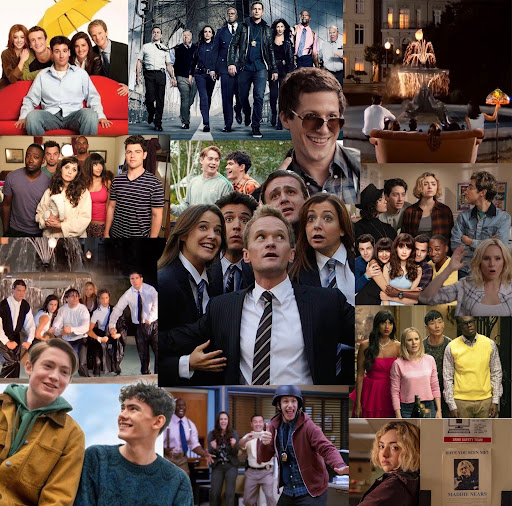Swept Away

This movie poster, which was released in order to stir excitement for the movie, is the perfect demonstration of chaos that is signature to this film.
June 12, 2022
Dive Into The Tumultuous World Of The Multiverse
Of all of the movies that were released this year, “Everything, Everywhere All at Once” really stood out. The thing that drew me to this movie was the concept of infinite realities, and how that theory was used to show an important message to the audience. The multiverse theory says that our universe is just one of an incomprehensible number, each with unique differences that set it apart from the others. In the world of the movie, there is a way to jump through the multiverse and access realities that normally would be unreachable.
This film is different from many other movies that are based on this idea. The tone is a stark contrast to the tones of other movies based on the multiverse: it is at times heartwarming, comedic, serious and tragic. The movie was written by directors Dan Kwan and Dan Scheinert to convey a deeper meaning about family, and the pressure that parents inadvertently place on their children. “Everything, Everywhere, All at Once” is also an immigrant story, a subject that is felt deeply in America right now, and one that directly ties into the theme of parental pressure in the movie.
“Everything Everywhere All at Once” is split into three separate parts. Part 1, “Everything”, begins with Evelyn Quan Wang, who is a laundromat owner under audit by the IRS. She appears to live a stressful, but otherwise mundane life, until an alternate version of her husband, Waymond, “verse-jumps” into his body using technology from the Alphaverse, or the “main” universe. He tells of an all-powerful multiversal threat, Jobu Tupaki, a being capable of freely jumping between realities, and altering the matter within them at will. He says that he is scanning the multiverse, searching for someone capable of defeating Jobu Tupaki.
Evelyn is brought into the quest to defeat the threat, until it is revealed that Jobu Tupaki is the Alphaverse version of Evelyn’s daughter, Joy, from the universe that her alternate husband jumped from. She was transformed into Jobu Tupaki after her mother, who was that universes Evelyn, pushed her too hard during a multiversal experiment, and fractured her mind across every single universe.
Forced to live every reality simultaneously, Joy becomes desperate, and creates the aptly named “Everything Bagel,” which is a bagel that Jobu Tupaki literally put everything on. It is a black hole, capable of consuming all of reality. Evelyn meets Jobu Tupaki, and her mind then becomes broken in the same way as Joy’s.
Part 2, “Everywhere,” starts with Evelyn spiraling through an infinite multiverse. She stabilizes, but realizes the futility that Jobu Tupaki feels, and the pressure that infinity places on a singular mind. She and Jobu Tupaki almost walk into the “Everything Bagel,” but Waymond implores them to stop and to stay with him, and to be together. Evelyn stops Joy from killing herself with the bagel, and we see how Evelyn chases Joy through the multiverse, trying to make amends for losing her in the Alphaverse. Eventually, she corners Joy in a universe, and tries to apologize for everything she’s done. Joy initially pulls away, but is convinced by her mothers earnestness. Part 3 “All at Once,” finishes off the movie with a momentary cut back of Evelyn to all her alternate selves, before she pulls herself back to her original universe.
This movie is so laced with symbolism and disguised meaning that it would be impossible to talk about every semiotic feature of the film. Instead, I’ll spend the last paragraph of this review on the most prevalent issue in the movie, which is the pressure placed on children by their parents. This issue is especially meaningful today, with many parents placing far too many responsibilities on their children, which can cause lifelong psychological and mental damage.
There are two instances of this in the movie. The first is the most obvious, which is when Alphaverse Evelyn pushes Alpha Joy to her breaking point, causing her mind to break across all of the universes. The directors have stated that this is a metaphor for anxiety, depression and even suicide that is caused by too much pressure.
The movie also looks at the pressure placed on immigrant children by their parents, which is shown by Evelyn’s father, Gong Gong, who constantly questions her about some of her life choices, saying that those are the reasons that she is where she is. The movie resolves these issues in the final act, with Evelyn confronting Gong Gong about the way he treats her, and apologizing to her daughter about all the mistakes she has made. This resolution goes to show how powerful one meaningful conversation can be, and how preventable some of the generational pressure is on families, immigrants and alike.
“Everything, Everywhere, All at Once” is a thrilling movie about the trials and tribulations of family, with an almost absurd plot and a powerful message. I highly recommend watching it, and letting yourself get swept up in the tumultuous world of the multiverse!



























Aoife • Jun 14, 2022 at 1:00 pm
This movies is so good, it really captures the complexity of both the multiverse theory while still having multilayered and relatable characters.
S Bache • Jun 14, 2022 at 12:51 pm
Great review Luke.
Joseph Hillyard • Jun 14, 2022 at 8:46 am
Loved this movie. Solid work!